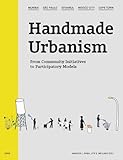Handmade Urbanism : Mumbai - São Paulo - Istanbul - Mexico City - Cape Town From Community Initiatives to Participatory Models / ed. by Marcos L. Rosa, Ute Weiland.
Material type: TextPublisher: Berlin : JOVIS Verlag GmbH, [2015]Copyright date: ©2013Description: 1 online resource (224 p.)Content type:
TextPublisher: Berlin : JOVIS Verlag GmbH, [2015]Copyright date: ©2013Description: 1 online resource (224 p.)Content type: - 9783868592252
- 9783868598872
- Bombay
- Bürgerbeteiligung
- Infrastruktur
- Istanbul
- Kapstadt
- Lebensbedingungen
- Metropolen
- Mexiko (Stadt)
- Nachhaltigkeit
- Partizipation
- Schwellenländer
- Soziale Bewegung
- Stadtplanung
- São Paulo
- Verstädterung
- ARCHITECTURE / General
- Bombay
- Bürgerbeteiligung
- Infrastruktur
- Istanbul
- Kapstadt
- Lebensbedingungen, Metropolen
- Mexiko (Stadt)
- Nachhaltigkeit
- Partizipation
- Schwellenländer
- Soziale Bewegung
- Stadtplanung
- São Paulo
- Verstädterung
- 307.7 307.760977
- HT371
- online - DeGruyter
| Item type | Current library | Call number | URL | Status | Notes | Barcode | |
|---|---|---|---|---|---|---|---|
 eBook
eBook
|
Biblioteca "Angelicum" Pont. Univ. S.Tommaso d'Aquino Nuvola online | online - DeGruyter (Browse shelf(Opens below)) | Online access | Not for loan (Accesso limitato) | Accesso per gli utenti autorizzati / Access for authorized users | (dgr)9783868598872 |
Frontmatter -- ACKNOWLEDGEMENTS -- INDEX -- Contents -- Introduction -- Introductory Interview: Returning to the Roots -- Initial Thoughts: Make the Invisible Visible -- Foreword: The Community -- Editorial An Urban Trend: Residents Taking Ownership of their Environment -- Five Cities -- Introduction to Five Cities -- Mumbai -- São Paulo -- Istanbul -- Mexico City -- Cape Town -- Common Points -- Four Interviews: Five Cities, One Gaze -- The Significance of Space in Urban Society -- Reporting from Local Initiatives -- Cities are an Expression of Human Needs -- Focus on Results: Attention to Real Needs -- Project Categories, Programs and Common Clouds -- Final Considerations -- Credits -- IMPRINT
restricted access online access with authorization star
http://purl.org/coar/access_right/c_16ec
Menschen interessieren sich für die Städte, in denen sie leben. Mit der weltweit zunehmenden Verstädterung wächst auch das Engagement der Bürger für „ihre“ Stadt. Fernab von traditioneller Stadtplanung nutzen sie ihre eingeschränkten Ressourcen und finden Lösungsansätze für die Herausforderungen in ihrem unmittelbaren Umfeld. Auf diese Weise schaffen sie soziale Infrastrukturen, die die Lebensbedingungen der Bewohner nachhaltig verbessern. Handmade Urbanism präsentiert 15 beispielhafte Projekte aus eher strukturschwachen Stadtvierteln in fünf Schwellenländern und untersucht dabei, welches Potenzial diese in Eigeninitiative entwickelten Projekte für den gesamtstädtischen Transformationsprozess haben. Wie sehen solche Initiativen „an der Basis“ aus, welcher Instrumente und Werkzeuge bedienen sie sich? Funktionsweise und Organisationsprozess der Projekte aus insgesamt fünf Metropolen werden anschaulich mittels Illustrationen dargestellt. Interviews mit Experten, Akteuren und Interessensvertretern beleuchten deren Bedeutung für die jeweiligen lokalen Herausforderungen. Im weltweiten Vergleich werden Unterschiede und Gemeinsamkeiten deutlich und nicht zuletzt übergreifende Lösungsansätze offenbar. Handmade Urbanism schildert, wie ein zeitgemäßes urbanes Leitbild aussehen könnte, das partizipative Initiativen fördert und deren Potenziale zugleich für den gesamtstädtischen Kontext – zum Vorteil aller – nutzt.
People have always been interested in the cities in which they live. With the world‘s stark urbanization, the engagement of citizens to improve their urban environments is also growing. Far from the traditional urban planning culture, they make use of limited resources, offering solutions to face the challenges these cities offer. They focus on the provision of social infrastructure aiming to improve the living conditions of the residents at the local scale. Handmade Urbanism showcases 15 projects realized mostly in less favored areas of five major cities in emerging countries, examining the potential of urban transformation embedded in community initiatives. What is the basis for such initiatives? Which are the instruments and tools they use? Illustrations depict their operational modes, reveal the actors involved and trace the steps they made in the organization of the initiatives. Interviews with experts, actors and different stakeholders clarify their meaning towards the local challenges. At a global level, common threads and differences are made clear. Handmade Urbanism drafts a possible urban vision of the city impacted by those processes and organizes a discussion that promotes participatory initiatives while exploring their potential to impact on the city at large – to the benefit of all.
Mode of access: Internet via World Wide Web.
In English.
Description based on online resource; title from PDF title page (publisher's Web site, viewed 30. Aug 2021)


